Celebrating Rye Breads
This weekend has involved multiple home bakes as I feed up my leavens in preparation for the 2 day “UK Fresh Loaf” course which I will be running at the College on 19th and 20th July. Many thanks, in particular to ruralidle for suggesting this in the first place, and for his work to make it happen. It will be my swansong at Newcastle College, as I am leaving at the end of this month in search of more exciting professional adventures in the wake of the savage cuts currently being inflicted across the board by the ruthless and deeply unimaginative Government currently in power over here. The result is that the College has re-structured to continue to attract sources of funding without being brave enough to find ways to continue to fulfil a key aspect of its traditional role in UK education. I am not short of ideas and leads, so am optimistic that a far more exciting future lies on the horizon. The only definite part of the plan is to make sure I complete my MSc in Food Policy between January and August of next year.
So, the show, very much, goes on. Here are the breads I made at home over Friday, Saturday and Sunday [8th – 10th July], having started refreshing the 2 leavens on Thursday evening, 7th July 2011.
1. Caraway Rye with Blackstrap Molasses
This is a bread I first developed and made some time ago, not long after joining the TFL community and beginning this Blog. You can read about it here: http://www.thefreshloaf.com/node/16273/carawy-rye-bread-black-strap-molasses-superwet-ciabatta-too This version is, however, quite different in that the leaven is wheat-based, with Dark Rye being added at the dough stage. The original used a Rye Sourdough with only wheat flour added to the final dough. There is half the amount of caraway in this formula, as this is all the stock I currently had in. More detail on taste is given below. I made 2 large miche type loaves from this dough; the recipe/formula and method detail are shown below:
Material | Formula [% of Flour] | Recipe [grams] |
1. Wheat Leaven Refreshment One | 18:15, Thursday 07.07.2011 |
|
From Stock |
| 40 [25 flour, 15 water] |
Marriage’s Strong Organic White Flour |
| 100 |
Water |
| 60 |
TOTAL |
| 200 |
2. Refreshment Two | 13:30, Friday 08.07.2011 |
|
Wheat Leaven [from above] |
| 200 |
Marriage’s Strong Organic White Flour |
| 300 |
Water |
| 180 |
TOTAL |
| 680 [40 retained as stock] |
TOTAL used |
| 640 [400 flour, 240 water] |
3. Final Dough | 19:00, Friday 08.07.2011 |
|
Wheat Leaven [from above] | 40 [25 flour, 15 water] | 640 [400 flour, 240 water] |
Carrs Special CC Flour | 50 | 800 |
Bacheldre Organic Dark Rye | 25 | 400 |
Organic Blackstrap Molasses | 6.25 | 100 |
Salt | 1.75 | 28 |
Caraway Seeds | 0.9 | 14 |
Water | 50 | 800 |
TOTAL | 173.9 | 2782 |
% pre-fermented flour | 25 | - |
% overall hydration | 65 | - |
Method:
- Weigh the dough water, and dissolve molasses and salt into that. Add the flours and caraway seeds and mix until clear. Autolyse for one hour.
- Combine the leaven and autolyse and develop the dough. As Shiao-Ping originally noted, the empirical feel of the dough is akin to much higher hydration than that actually used. This is the effect of using molasses and 25% rye flour making the dough very sticky indeed. Persevere with slow and gentle mixing, avoiding adding any flour at all to the dough. I used Bertinet’s slap and fold here, mixing for almost an hour, but with lots of resting phases along the way.
- Bulk ferment for 2 hours
- Retard for 7 hours, overnight.
- Scale, divide and mould the dough pieces. I scaled one at 1550g and the other at 1200g and placed each piece upside down in prepared bannetons. The large loaf stayed out for proof, and the other went back in the chiller for a further 2 hours to give a manageable production schedule, with the second bread following, then another bread after that. Final proof time for loaf one was just short of 4 hours, and for loaf two exactly 5 hours.
- I cut the tops of each loaf with a diamond pattern and set them to bake at 220°C using plenty of steam. For the bigger loaf, I baked it for 15 minutes at 220°C, then 20 minutes at 200°C, then a further 15 minutes at 180°C. The smaller loaf baked the same, but for 40 minutes instead of 50 minutes.
- Finished loaves cooled on wires, as always. The baked loaves had a finished weight which showed moisture loss of just under 10%. I achieved a core temperature of 96°C for both loaves.
Some photographs of the finished loaf are shown below. Regarding analysis of the finished bread, this is one of Alison’s absolute favourite loaves. There is sourness and bitterness coming from the rye and molasses. There is sweetness too, and plenty of aroma from the caraway. The crumb colour is particularly lovely, and the moistness brings great pleasure to the final eating quality. We took one of these loaves along as a gift to some friends’ house last night, as we had been invited round for dinner. That was the first chance we had to sample the bread, but we had a slice each for breakfast this morning, with just a thin coating of butter.
2. Borodinsky – The Auerman Formula [or thereabouts anyway]
I have now tracked down a supply of Red Malt, and managed to find a way to fit the more complex 3-stage build used for this bread into my home schedule for the last couple of days. It’s something I have long wanted to do, have been slightly taken to task for previously on TFL, and am really happy with the finished result; subject to tasting and crumb analysis which I have yet to carry out.
I made one large loaf, in a Pullman Pan, weighing just over 1660g
Material | Formula [% of flour] | Recipe [grams] |
1. Rye Sour Refreshment | 18:15, Thursday 07.07.2011 |
|
From Stock |
| 70 [26 flour, 44 water] |
Bacheldre Organic Dark Rye Flour |
| 60 |
Water |
| 100 |
TOTAL |
| 230 |
|
|
|
2. Full Sour | 13:00, Friday 08.07.2011 |
|
Rye Sour from above |
| 230 |
Bacheldre Organic Dark Rye Flour |
| 180 |
Water |
| 300 |
TOTAL |
| 710 [38 retained as stock] |
TOTAL used | 80 [30 flour, 50 water] | 672 [252 flour, 400 water] |
|
|
|
3. “Scald” | 22:30, Friday 08.07.2011 |
|
Bacheldre Organic Dark Rye Flour | 20 | 168 |
Red Malt | 5 | 42 |
Organic Blackstrap Molasses | 6 | 50 |
Coriander, freshly ground | 1 | 8 |
Salt | 1 | 8 |
Boiling Water | 35 | 294 |
TOTAL | 68 | 570 |
|
|
|
4. “Sponge” | 23:30, Friday 08.07.2011 |
|
Rye Sourdough [from 2] | 80 [30 flour, 50 water] | 672 [252 flour, 400 water] |
Scald [from 3] | 68 | 570 |
TOTAL | 148 | 1242 |
|
|
|
5. Final Paste | 07:30 Saturday 09.07.2011 |
|
Sponge [from 4] | 148 | 1242 |
Bacheldre Organic Dark Rye Flour | 23.5 | 197 |
Carrs Special CC Flour | 26.5 | 223 |
TOTAL | 198 | 1662 |
% pre-fermented flour | 50 | 30 from sour + 20 from scald to make “sponge” |
% overall hydration | 85 | - |
Method:
- Refresh the rye sour as directed in the table above.
- Make the “scald” as follows: Weigh the red malt and dark rye flour into a bowl, add the salt, and coriander, which should be freshly ground using a mortar and pestle. Weight the molasses into a pan, and pour boiling water onto this to the specified weight. Bring this to a rolling boil on the cooker hob top. Pour onto the dry ingredients and combine well with a stout plastic or wooden spatula. Add any extra boiling water required first by checking the weight of the contents to allow for any evaporation. Cool the scald as rapidly as possible down to a maximum temperature of 45°C. This took an hour.
- Combine the scald and the full sour to form the sponge. Leave this to ferment for 5½ hours. I then retarded it a further 2 hours, as it was 05:00 and I needed a bit more sleep!
- Add the 2 remaining portions of flour to the sponge to form the final paste
- Prove in bulk for 1½ hours, and meanwhile prepare a large Pullman Pan by lining it with silicone paper.
- Pan the paste, smooth it off and dust the top with a sprinkling of freshly ground coriander. Put the lid on the Pan and set for final proof for 2 hours.
- Use a pan of water in the oven and set to bake at 160°Cfor 2 hours, with a gentle supply of steam, topped up as needed.
- De-pan and cool on wires. The finished weight of the cooled bread was 1400g, indicating a weight loss of 15.8%. This means that the moisture retained within the bread remains at just under 70% of the flour, and equates to 35% of the total weight of the finished bread!
Notes:
- Red Malt: this is derived from malted barley, ground to a fine powder. I believe it has been lightly roasted to the levels which would be known in the brewing industry as “Crystal Malt”. In terms of amylase, it makes no contribution, as the grain has been roasted at too high a temperature for the enzymes to survive. I suspect the Russian version would use rye as the source, rather than barley, but this is as close as I can get at the moment. It looks like this:
- Constructing the Scald: I did this exactly the same as I have done it in the past, except for using the red malt instead of the barley malt syrup which I have previously had to use as an alternative. The formula does not use molasses or salt in the scald. The reason I added the molasses at this stage is because I did not want to use sugar in the formula, as the “official” recipe directs. Adding molasses to the final paste would be a difficult mixing process, as there is no liquid added at this stage to use to dissolve the molasses into.
- Additionally, the sponge process had to be left for longer than the 4 hours directed in the formula, on account of me requiring a bit more sleep. So I added the salt in the hope it would retard the ferment. I also hoped that the level of molasses in the formula would be sufficiently high to have a slight retarding effect too. In the event, I woke up 5 hours into the final fermenting phase, and stored the sponge in the fridge to retard it for just over 2 hours before getting up to make the final paste. This worked very well; some pictures of the dark and rich “sponge” are attached here.
- Undoubtedly this is the best version of this bread I have made. You can reach your own conclusions about the origins of the term “Borodinsky” from the various stories uncovered in the research posted above. I’ve never been to Russia, and have no idea what the “official” Borodinsky produced in Soviet times, or, the older, traditional loaf of its type tasted or looked like. This version is stunning. The bitter/sweet flavours are intense, the crumb is DARK, and very moist. For all that, it is very easy to eat, and intensely “moreish”!
- References: there is more information about the Borodinsky formula given below. Some of these are taken from previous discussion threads of interest on TFL. This one http://www.thefreshloaf.com/node/11812/rye-amylase is of interest in that discussion is given over to the part played by the scald in the formula, and the extent to which the water should be heated before it is poured onto the flour. Here, I am left wondering if the key purpose of the scald is to fully gelatinise the starches in order to encourage maximum liquid take up in the final formula? Or, have I still not got this part right, and missed that the scald is actually a “mash” and not a “boil up”? Informative further discussion on mash chemistry and its potential impact here would be much appreciated.
- I did then go on to complete the process as outlined originally by Borodin, by combining the sour and scald. However, I wonder if, because my scald was a “boil-up”, and not a “mash”, whether that meant the sponge would not work exactly as intended, and as outlined here in an earlier post on the referenced thread: http://www.thefreshloaf.com/node/11812/rye-amylase#comment-66360
- Two clear derivations are offered for Borodinsky bread, and this topic seems to spark off heated debate about what is the “true” Borodinsky. Is it a black bread created in the immediate aftermath of the Battle of Borodino, to celebrate the Russian army success in 1812? Or, is it the heavily prescribed Soviet bread of the GOST standards, as referenced here: http://www.borodinsky.com/recipe/index-r.html on this thread: http://www.thefreshloaf.com/node/20370/russian-sourdough-no-more My attempt here was to re-produce the latter style, and I acknowledge I have not been entirely successful. Some of this is deliberate…avoiding sugar, and replacing it with molasses. The story on the zavarkha is another matter. Can anyone provide further detail on whether the process is carried out primarily to mash, or, to gelatinise? That would be much appreciated; if we can avoid derogatory comments this time, that would be all the better.
- For further information, I highly recommend reading the various discussion posts here: http://www.foodbanter.com/baking To do this, you will have to register. Then use the “Search” tab in the top menu, and type “Borodinsky” into the search box when it comes up. Select the threads you want to see from there.
For information on the very precise rye bread recipes from the Soviet era, see this table here: http://www.indiana.edu/~pollang/Russian_bread_table.pdf
I would like to dedicate this bread and post to my friend and TFL colleague Daisy_A, and pass on all good wishes for a speedy recovery, as I know you are having an operation on one of your eyes round about now. Your intellect shines through in some of the passages referenced above and these typify the enormous cultural contribution you make to the pages of TFL. “Get well soon!”
3. Pain de Campagne with mixed levains
Just a quick one, to give me an excuse to feed up the rye sour and wheat levain one more time. Recipe/formula and method below for one large loaf in a banneton. The refreshment programme for the 2 leavens is not given, however, I used the cultures leftover from the previous 2 doughs, fed them each once more, and used these to make this bread, returning small amounts of each to stock for re-generation.
Material | Formula [% of flour] | Recipe [grams] |
Wheat Levain | 36.1 [22.5 flour, 13.6 water] | 256 [160 flour, 96 water] |
Rye Sourdough | 36.6 [14.1 flour, 22.5 water] | 260 [100 flour, 160 water |
White Bread Flour | 63.4 | 450 |
Salt | 1.7 | 12 |
Water | 31.8 | 226 |
TOTAL | 169.6 | 1204 |
% pre-fermented flour | 36.6 | - |
% overall hydration | 67.9 | - |
Method:
- Combine all the items in the table in a bowl to form a dough. Mix by hand on the bench for 15 minutes.
- Retard overnight in the fridge.
- Mould round and place upside down in a prepared banneton.
- Prove for 5 hours
- Score the top of the loaf, and bake in a pre-heated oven with steam, for 45 minutes.
- Cool on wires.
A somewhat less detailed formula to finish with. Photographs of the crust and crumb are here. The loaf has gentle flavours in comparison to the full-on tastes of the other 2 breads.
Happy Baking!
Andy
- ananda's Blog
- Log in or register to post comments
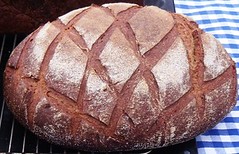

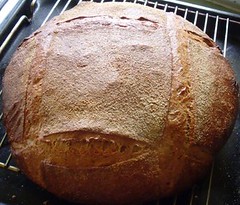
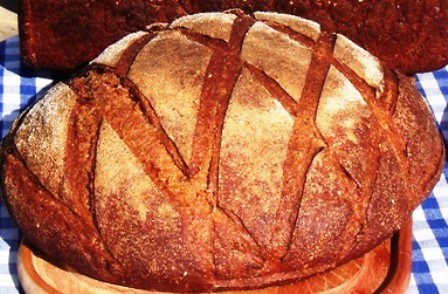
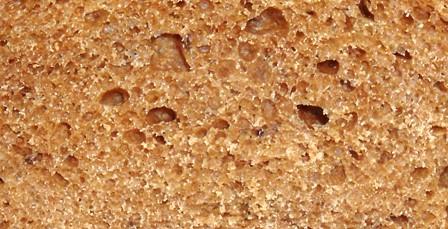
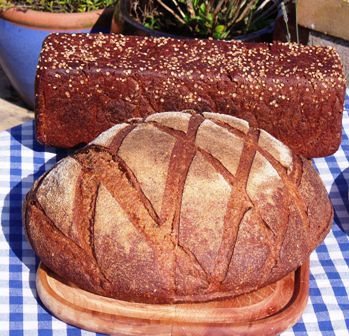
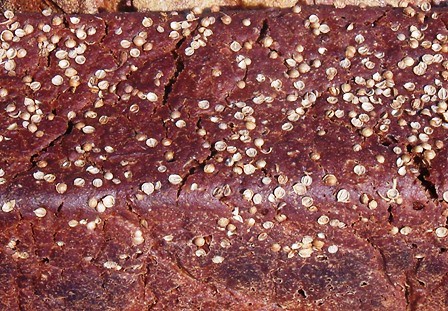
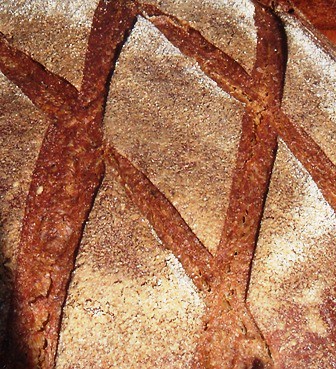
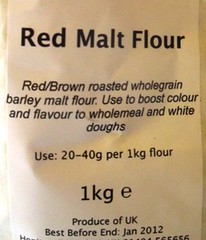
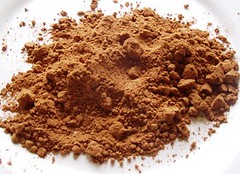
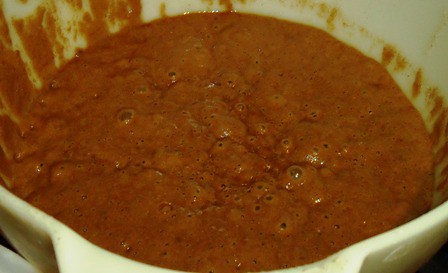

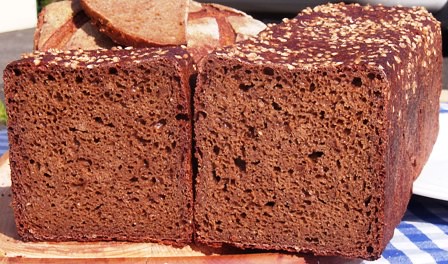
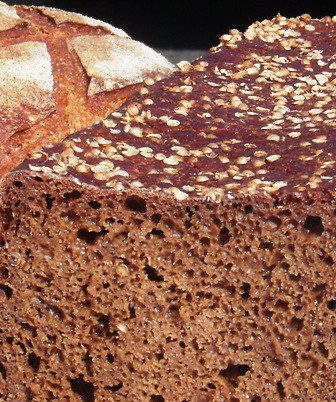
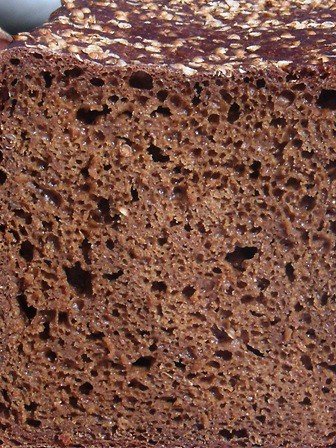

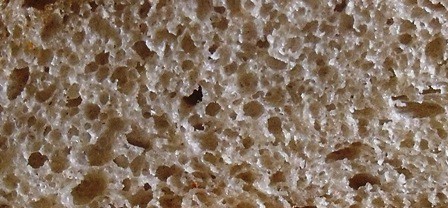
I think they are all "moreish."
Best wishes for a successful career shift! I'm staying tuned waiting to learn where you land.
David
Thank you David,
the rate of consumption suggests "moreish" to be an accurate assessment.
IIt could be a bumpy ride, but it will be exciting and a challenge, and I really don't know where I might land. Thank you for your good wishes
Andy
A beautiful trio of rye breads! Your passion and dedication are inspiring, as always. This a great example of post that doesn't just give answers, but gets me asking questions I didn't even know I needed to ask! Thank you.
Marcus
Hi Marcus,
What a lovely comment for me to read, thank you so much. Now on to those questions you need to ask!
Very best wishes
Andy
And what a celebration it is, thanks for taking the time to share!
Sylvia
Hi Sylvia,
How apt are those 2 words when applied to bread? Sharing and celebrate
Quite right!
Thank you for noting this
Andy
Hi Andy,
Once again a terrific looking group of breads from your skilled hands! The crumb on all 3 is beautiful, and the diamond scoring on the caraway rye is very attractive. I've followed many, if not all of the fine Borodinsky bakes you've posted but you've taken this one a notch or two higher still. Love the rich reddish brown colour of the crust and crumb. The preferment almost looks like a chocolate cake batter and good enough to eat as is. I'll be looking to source some of that red malt flour myself before I finally try making the Borodinsky.
It's really a shame about the funding with the College and a terrible loss to the students who will be deprived of your baking knowledge and experience. The flip side of that is that in the next little while some organization, whether it's commercial or academic, will become very fortunate indeed if you decide to accept a position with them.
All the very best Andy,
Franko
Hi Franko,
No doubt about the improvement in the loaf colour and flavour brought about by the red malt.
If you track it down, please check whether it is sourced from barley or rye! Rye would be authentic in Russia, I believe, but barley is widely available as it is an adjunct used in the brewing industry. I'm sure it's the darkest crumb I've achieved so far, but there is little bitterness in the taste, despite rye sour and molasses in the formula; these are balanced by the sweet maltiness from the red malt and the extra process. I'm still not sue I've got it quite right, but will raise that further with Nico lower down.
Your support and belief as a professional baker of such obvious skill and knowledge is very much appreciated...I thank you for that. I don't intend to rest on my laurels!
Very best wishes to you
Andy
Um. Apparently Borodinsky is not meant to have any bitterness at all. Not according to GOST, anyway
Andy,
Your loaves are as tempting as ever. On the governmental/political scene, it is a worldwide problem going far beyond just the UK. Change is good and exciting so I am happy for you. Undoubtedly you will let us know where you land.
Jeff
Hi Jeff, and thank you for your kind comments.
Interestingly, the people currently with the biggest smiles on their faces in College right now, are those in the same situation as me. Those that are left behind will have far too much work to do, and are living in dread of what next year will bring, and what lies beyond. Alas, it is of little comfort to know that other struggling but similarly privileged Nations are behaving in such an insanely naive way. As if the skills gap isn't wide enough already...it's going to get a lot worse.
I'll keep you posted on progress
Best wishes
Andy
Andy, I always save your posts on rye especially. They will serve me well in the future. Thanks, and good luck going forward. There is a strong demand for talented bakers these days who can also explain what they are doing.
Hi louie,
Thank you for your support, and I agree with your premise.
The time for the re-emerging bread bakers of the UK is NOW. I guess with using the logo up on the right, many of you would have already worked out that is fundamental to my belief and commitment to the baking industry today and for the future.
Best wishes
Andy
Hello Andy,
Thank you for this very interesting and detailed post. Your breads are very inspirational...their appearance is beautiful, with really lovely scoring, and crumb (the color imparted by that red malt is stunning). The flavors sound amazing too.
I want to wish you the very best as you pursue your studies. Your future co-workers/partners/students will be very lucky indeed...you have so much knowledge and talent to share.
Thanks for sharing so much here on TFL.
:^) from breadsong
Many thanks for your compliments about these loaves, Breadsong, it is much appreciated.
You are so right to remind me that the excitement and challenge ahead, professionally, is indeed twofold. New work, and completing the Masters degree too! My search for new work has to balance both these factors.
All good wishes
Andy
Hi Andy,
I meant to also wish you the best for your "UK Fresh Loaf" course.
Wish I were closer - if I were it would have been wonderful to sign up and have this opportunity to study with you,
and the others attending.
from breadsong
visually of course. I have also enjoyed hearing about your teaching at "the college" and looking forward to hearing about whatever you decide to do next. Best of luck! -Varda
Thank you varda, I am looking forward to writing more posts about my baking antics, and how they link to my new movements in the world of the baking profession...wherever I end up
Best wishes
Andy
Another fine selection of loaves, Andy. And now I know why all your loaves have that beautiful reddish hue to them: it's your red malt flour! I wish you all the best in your new adventures,
Syd
Hi Syd,
I cannot deny the importance of the red malt in improving this particular Borodinsky over previous attempts. But it is genuinely the first time I have ever used Red Malt, either at home, or in the workplace!
Best wishes
Andy
Wonderful looking Rye Breads Andy. I haven't made a Borodinski in a while but every time I see your weekend round up with a beautiful one it makes me want to do it again. The malt looks great.
Best of luck in finding a place to hang your hat. These are trying times we live in my friend. Best of luck in your days ahead.
Best wishes,
Eric
Hi Eric,
It's always so good to hear from you, and I am happy to hear you hope to make the Borodinsky again some time soon. I look forward to reading about it.
Yes, indeed these are trying times, and I don't see our economic or political situation getting better that quickly here in the UK either.
You have been a constant source of support to me since I first started posting here, and the way you extend that to so many here, and have done for so long is part of the reason TFL is what it is. I am sure I speak on behalf of many when I thank you for this.
Very best wishes
Andy
Wonderful selection of breads, as usual, Andy!
Really sorry to hear about your work. But, as everybody said, I'm pretty sure you'll be able to find a new place where people will benefit greatly from your skill and knowledge you have accumulated before too long. Best of lucks!
lumos
Many thanks for your kind words of support lumos
All good wishes
Andy
Hi Andy, as you can guess -IMO- the Borodinsky bread you made this time outshines all the others, even though they look so nice! Your questions about the scalding in the Borodinsky are the same I've wondering about for a couple of years, the intentions underlying the scalding are still something to be fully understood as far as I can tell.
I wish you the best of luck. The company that hires you will make a very fortunate choice!
Hi Nico,
Yes, I agree that this is better than all the other Borodinsky loaves I've made...and I made literally thousands every week for almost 10 years in times past.
And yet, by incorporating that extra stage, I have uncovered further gaps and a big dilemma which needs an answer.
Is the "scald" a boil up, or, a mash? Adding water on a rolling boil will maximise starch gelatinisation and achieve the greatest moisture take up in the flour. Adding hot water to the flour to achieve a holding temperature of 62 to 66*C over a lengthy period will extract the maximum amount of sugar for the yeasts to work on and engender maximum amylase activity too. But the boil up would occupy a much shorter time span than the mash; so a completely different production schedule would be needed next time if I were to change the focus of this hot soaker.
Your words of support are very much appreciated, and your knowledge and commitment to baking with rye keeps me always challenged, and, inspired
Very best wishes
Andy
"Is the scald a boil up or mash?"
Reading these tfl threads on borodinsky is like déjà vu for me, going back to discussion from early 2000s on alt.bread.sourdough. Ronald Feldman and Leonid Hofer argued about borodinsky malts, between royter, bolgov, and auerman formulas, three and four stage processes. (No one made his own red malt though, like you radicals.). And we had a heated debate about this very "mash" question!
Being tired of theory, I finally just baked two breads with both types of scalds, and in the end couldn't personally tell a difference, so msintsined the easier boil-and-cool, just like you use.
If anyone wants to experiment with true "mashing", you'd have your oven at 70 or 80C, and, instead of air cooling, let the scald maintain at a strict 63-65C temp for 2 or 3 hours, then cool to 30C and proceed to make sponge. In other words, an already tedious three stages becomes four! You can tell my bias. In the end, as Calvel says, the proof is in the loaf. But I'd love for someone here to repeat the experiment.
Truely Stunning bordonsky Rye, Andy.. from your descriptions, i can smell the intense Rye scald+malt steaming from the screen! How lucky you are to have perfected a full flavoured bread such as the beautiful one pictured above.
The rest of the breads look lovely as usual. As to University career, and with all the experience you've accumulated, i'am sure you will find a better, more promising career soon. Keep us posted, please, andy.
Best wishes,
Khalid
Hi Khalid,
Yes, I believe the flavour in this Borodinsky is superior to my past attempts, though I'm not sure it is perfected. There is so much discussion on this bread, and I have such limited knowledge of authentic Russian bread culture. But I loved the taste, and all others who tried it were similarly enthusiastic...I'll re-echo Sylvia's 2 magic words here.
It is difficult to leave a job knowing how much work I have put into it only to now realise its focus will never come to fruition. However, I readily accept that my focus for the future, and the new priorities of the College are very different indeed. As such, I agree that a better and more promising career is the essential move forward to be making right now.
All good wishes
Andy
Just found out that you're off on the road (as a 'journeyman', perhaps?) about three weeks later than everyone else on TFL. (Oh, well, I've been very busy...fifth grandchild born in rural Japan ten days ago and hours of travel back and forth to visit her...working overtime for the first time in 6-7 years!)
I'd just started 'step one' of a 3-day build on my (so-far) favourite rye bread, before I read your post. I'm glad I did that, now! Red malt flour? Not in Japan, sir! (No spelt, no kamut, no dark rye flour either...)
I'm just posting because I want to re-iterate the congratulations on the rye bake and the good wishes for your future that you've already received. A man with your talent and knowledge is destined to rise like a perfect loaf, so the 'best of British luck' to you, sir!
Sincerely,
copyu (Adam)
Adam, thank you very much for your good wishes and kind words.
I can't help but feel that, for real bread in the UK, "the time is now!" So, I am in a very good place in my head, and confident I have much to give, as ever; and satisfying ways to make a living too.
Yes, I can see you might be challenged in making certain breads out in Japan. I know you make the most of what you do have to work with.
All good wishes
Andy
Hello Andy,
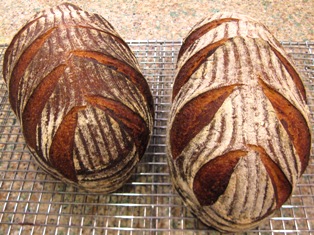
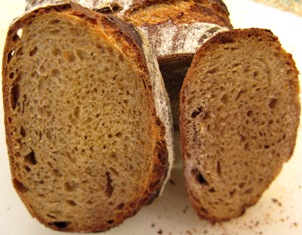
Awhile back, while looking at one of Mark's videos (Three Breads from Start to Finish) on the Back Home Bakery site,
I took note of Mark mixing up a completely-delicious-looking Swedish Rye, with molasses and orange.
I've thought about that bread often!
Seeing your beautiful caraway molasses rye here (and formula generously shared)...I couldn't wait to try making your molasses rye, adding some orange zest (and anise seed in place of caraway, from flavoring described in my Laurel's Kitchen Bread Book). I'd been really wanting to try a sourdough molasses rye formula; your formula makes some incredible tasting bread.
I don't know if I got the crumb I should have, but my goodness, the bread does taste really good.
Thanks again Andy.
:^) from breadsong
Hi breadsong,
they look lovely loaves. I know a baker in our city who uses orange juice in all his wholewheat loaves. Where the citric acid levels in lemon are high and cause gluten to break down, the lower levels in orange juice seem to allow him to get the benefit from the Vitamin "C" [ascorbic acid] acting to strengthen the dough.
I'm sure the flavour combination is outstanding. Did you use the really strong blackstrap molasses I used? If so, did you keep the level at 6.25%? I love the way you can see the orange colouration of the crumb.
All good wishes
Andy
Hi Andy,
Thanks :^), and noting what you're saying about orange juice; would like to try adding some to dough for its effect.
Oddly, in wanting orange flavor in this bread, I used only the zest and not the juice...but was needing the orange fruit for another purpose, this time around :^)
The molasses I used was 'Crosby's Fancy Molasses', at 6.25%.
There's a little shop in town that I'm pretty sure sells blackstrap. I'm almost out of the Crosby's so for the next bake of this bread, I'll try finding/using blackstrap molasses.
:^) from breadsong
It's very strong, Breadsong. Just to warn you in case you haven't used it before.
Let me know how you get on with OJ!
Best wishes
Andy
Oh by the way, I've got a packet of Bacheldre Stonegroudn Rye Flour - their website doesn't list any other type of rye flour, has the Dark Rye you used been discontinued?
I found mine to be rather coarse (or maybe there's just too much bran, it being stoneground?), I need to add at least 25% wheat flour otherwise the crumb is just too coarse for my liking. Every Russian language description of Borodinsky I've come across says the rye needs to be ground to a medium or even fine grade.
hi Andy,
I accidentally deleted the previous version of this post so will have to start again :(
I don't know what your Borodinsky tastes like but it certainly looks very very authentic! If there is such a thing as authentic Borodinsky. Until 1920s when the GOST on it was introduced, it was apparenly a type of bread rather than any particular recipe or method, so I suppose there is room for manouvre :)
the only difference between your loaf and the ones I used to eat back in Russia is that Russian (commercial) Borodinsky has a very slightly convex top, whereas yours is a little concave. Also the top is very very dark, almost (but not quite) burnt, I'm assuming they don't use a lid on the bread tin. Oh, and the holes in the crumb are meant to be quite uniform. Not sure how that affects the taste tho.
You were right to use molasses, although apparently Borodinsky must have some sugar in it too. Molasses are used for chemistry while sugar is added for a better taste, and substituting all sugar with molasses deteriorates the taste. Or so this source says http://www.borodinsky.com/history/1930/1930.html sorry it's all in Russian but i always try and quote my sources, in case :) It also says that while sugar is added purely for better taste (usually to a ratio of 2.5% to the total weight of flours), replacing it entirely would affect the quality of the crumb and make it too sticky. I'm getting confused here...
If it helps, here's the list of ingredients according to GOST, per 100 kg ready bread:
rye flour - 80 kg. GOST calls for 96% extraction, medium grade milled, but the above source says that zavarka is best made with rye at 87% extraction and as finely milled as possible.
wheat flour - 15 kg. This is "2nd grade", described as soft, greyish flour with a high bran content, ash content 1.25, min gluten 25%.
potato starch -0.2 kg. So far as I'm aware it's just another way to saccharise the dough.
Red malt - 5 kg. Above source says it's possible to substitute red rye malt for something called "white barley malt" which is less acidic, more sugary and has a higher diastatic activity than red malt, does that make sence to you? Light barley malt perhaps?
Salt - 1 kg
Fresh (pressed) yeast - 0.1 kg. This is to be used alongside sourdough.
Sugar - 6 kg
Molasses - 4 kg
Oil (probably sunflower) - 0.05 kg
UPD: the oil is probably for oiling the moulds.
Coriander - 0.5 kg
Total ingredients - 111.85 kg
Pre-GOST breads could also be flavoured with caraway, coriander or aniseed, but these days Russians associate Borodinsky with coriander and Rizhsky with caraway.
I'm only a novice bread baker and so far know very little about dough chemistry so I can't directly answer your question RE the role of zavarka, but this is what I found. Zavarka is used primarily to extend the bread's shelf life (i.e. slow down staling), as well as to preserve its sour-sweet taste and give it a darker colour. Zavarka with molasses is meant to extend shelf life by as much as 5 days, whereas one with just malt and no molasses, by 3-4 days. Does this help you solve your gelatinasation VS saturation quest at all?
Hi Faith,
Thank you for your comments on the Borodinsky bread in this post.
I was pleased not to have bitterness in the finished loaf, and agree with your findings. My concerns stemmed from using no sugar, only molasses at 6% on flour, plus the red malt. This makes the formula somewhat less sweet than the GOST standards. Additionally, the Black Strap Molasses I use is very strongly flavoured with distinctly bittersweet overtones.
Regarding the Bacheldre, I have been using this flour for sometime now, and I absolutely love it. However, I readily accept it is not the grade of rye flour conventionally used in Borodinsky. If you want to find that, I recommend using Shipton Mill. When I worked for Village Bakery, we used all Light Rye in the final paste...so, 70% of the flour. There was no wheat in that particular version; I posted it here, although please note, we did not use a scald or sponge in this version: http://www.thefreshloaf.com/node/2615/russian-recipe-borodinsky-borodinski-bread#comment-120249 For Shipton Mill Light Rye look here: http://www.shipton-mill.com/flour-direct-shop/rye-flours/shop-42/organic-light-rye-flour-type-997-601? [I apologise, but the "?" at the end of the link is showing up in black, not brown. It is part of the url, so you may have to paste the link in manually].
I don't really like Light Rye that much myself, as I find it very "claggy". That said, it performs much better in bread, particularly effective for binding and increased volume. I have had some tremendously coarsely ground Bacheldre Dark Rye Flour, see here: http://www.thefreshloaf.com/node/23415/baking-allbritish-flour#comment-169076 However, the bags I have bought lately are quite a bit finer. For all that, the high ash content has serious impact on water absorption. 85% water on flour for the Shipton Light Rye would be very optimistic indeed. Let me know how you get on with this.
Yes, I used the "boil up" exactly as you say....to extend the shelf life. My take on this is that maximum gelatinisation means the flour will take up a lot more water, and this gives the increased shelf life. However, further reading suggests the purpose of the zavarkha is to create a "mash", not a "boil-up", and I interpret this is to open up all the sugars and amylase in order to create a highly active ferment when combined with the sour to make the 2nd stage "sponge".
Thanks again for your comments; I've used your real name, hope you don't mind? I am a little uncomfortable with your username.
Best wishes
Andy
Lol,
no prob at all, Andy. I'm only calling myself FoodFascist because I won't let anyone give my toddler junk food, that's all :) well, and also because I'm forever running out of ideas for usernames.
I did read that replacing all of the sugar with molasses makes the bread taste "too malty" :) whatever that means. Yours must have come out "too molassy" then :)
I have looked at Shipton Mill, thanks, they actually do dark rye as well as light rye and they grind them to a medium grade which so far as I can work out should be very close to Borodinsky requirements. Well, not just Borodinsky, I think most archetypal Russian rye breads use medium flour or similar. Maybe fine too, I'm not sure.
I think the Bacheldre I'm using now is a light rye, or at least it doesn't say on the package that it's dark. Which is why I was a bit baffled to find that there is no mention of your Organic Dark Rye on their website. The loaf I made with it doesn't taste quite as rye-ey as commercial Russian breads I'm used to, but that may be for a multitude of reasons other than just the type of rye, the fact that I used about 25-30% wheat for example.
I tried making rye bread about a year ago and that was a total failure, it tasted nice but the texture was like a brick. The reason as I know now is that I used active yeast that time as I was totally ignorant of sourdough, none of the rye recipes I had mentioned sourdough either. This time round I made a sourdough starter and left the dough to ferment to it's heart's delight - this made all the difference to both the taste and the texture! I was really amazed how sourdough culture softens the coarsely ground rye so much it becomes fluffy and chewy, nothing compared to active yeast.
What would you say about mixing dark and light rye? Would adding light to dark improve binding? If so, what sort of ratios would you suggest? I'm not aiming for a 100% totally authentic Borodinsky, I already mentioned the claim by my Russian language source that Borodinsky before GOST was a family of very different formulas and methods, some of those didn't use scald, some didn't even use malt, and the method most widely used in home baking produced the least sweet or aromatic bread. So really, I don't think there can be such a thing as "authentic" Borodinsky. So long as it tastes good, has a nice texture and is sour-sweet with a hint of malt that should do me.
Faif.
Hi Faith,
Yes "too molassy"! Although, that was the flavour I wanted anyway.
Shipton flour is ideal for Russian Rye breads. We used the Dark Rye as the base for the rye sour. The flour from the sour in the Borodinsky Village Bakery formula was 30%. The remaining 70% was the Shipton Light Rye.
I posted a good bit more on the Bacheldre flour here: http://www.thefreshloaf.com/node/23415/baking-allbritish-flour
The batch I had in at the time was tremendously coarse, nicodvb described it as sawdust! Subsequent batches have been much finer. I don't mind really; the secret's in the sour as you have discovered!
Anyway, it's not called Dark Ryem, you are absolutely right. I think i labelled it as that on account of the appearance of the earlier coarse versions. It is, however, a stoneground flour using the whole grain. So, it's much closer to Dark Rye than any of the other variations commonly found.
Interestingly enough the label on the product illustration on the Co website, here: http://www.bacheldremill.co.uk/shop/details/?q=7 is slightly different to the current flour I have in stock.
However, I am surprised what you write about the Bacheldre lacking a bit of flavour; the reason I use this flour is that I find it produces the best ferment, resulting in the best flavoured rye breads....and I rank it way above the Doves Farm and the Waitrose own label, and superior to Shiptons rye flours too.
Can you give us more information on your Russian language source and fill out the comments you make about Borodinsky before GOST. I would really like to read what you have to say about this, and I'm sure my colleague DaisyA would be equally interested too.
All good wishes
Andy
sorry Andy, I'm a bit confused - I didn't say Bacheldre flour lacked flavour? Which bit in my post made you think that? If it's that I said my Bacheldre loaf didn't taste as rye-ey as commercial Russian loaves, well that's probably because as I mentioned I didn't really follow the method and used too much wheat (I was worried the bread would be too heavy and sticky otherwise).
If it's "the method most widely used in home baking produced the least sweet or aromatic bread", that one is a reference to how my Russian language source describes pre-GOST breads.
Ive already quoted my main Russian source, it this one www.borodinsky.com Unfortunately there's no English version to it. I'll try and translate the bit about Borodinsky's history in full when I get the time.
The reference for the use of zavarka is this, http://mariana-aga.livejournal.com/67205.html but I don't know where this person got their information from and I don't quite agree with some of what she says.
Thinking about it, I recently came across a reference to a Soviet era Russian manual on bread technology, interestingly it came up on an English language forum. I downloaded the manual but because I was looking for recipes and it didn't have any I deleted it. I'll try and find it again because i think it explains the chemistry of zavarka, as well as many other technicalities. I'm wondering if that discussion was actually here on TFL...
on second thought, the flavour of rye flours available here and in Russia may differ anyway, due to (potentially) different cultivars grown, variations in climate and agricultural methods, storage conditions, etc. etc. Such variations wouldn't necessarily make one brand of flour more or less flavoursome than another, they may just have different flavours. You probably know more about all that than me. We'd have to trace back the exact sources of all the different brands of rye flour available to UK and Russian bakers to make a judgement.
Also, I don't ever expect my home-made loaves to taste exactly like commercial bread from Russia - apart from potentially differing ingredients, the differences in method would be HUUUGE. Due to the history of mass production in Russia, commercial bread is mostly made in very large-scale bakeries, the Russian word for them is actually "factory" (hlebozavod: hleb - bread, zavod - factory) as opposed to "pekarnya"(literally - bakery) which is the word for small-to-medium-scale production facilities which sadly make up a very small proportion of the market. What I'm trying to say is that I'll never be able to replicate the production process that makes bread by the tonne! And as you may agree this is probably a good thing. Home-baked bread made with honest ingriedients is always a winner ;-)
BTW Andy, a really daft question (but I'm a real newbie as I've mentioned) - what IS the difference between dark and light rye? Is it the degree of extraction? Or are they different cultivars/different ripeness or something? Russian bread bakers distinguish between 3 (I think?) main types of rye flour, sometimes with several sub-types, but I can't quite work out yet how these correspond to the types used here. Or could you perhaps point me to a good source that explains the relationship between extraction and the grade of grinding?
thanks in advance.
Faif
Hi Faith,
Rye is usually milled to ash content, [measuring the mineral residual when a portion of the flour is burned] by the specialist millers in the UK.
There are several types available, as follows:
Light Rye 997 [Shipton use the German Classification, indicating an ash content of 0.997%] is the most refined, being slightly grey, but finely milled with an extraction rate equating to around 85%
Medium Rye is less common in the UK, but can be found, with extraction rate at c.90%. It is of reasonably fine grind
Whole Rye Flour [Type 1350] Shipton sell this as Dark Rye, but I have ascertained in correspondence that it is a wholemeal just like the Bacheldre. Ash content is inconsistent here. A wholegrain rye flour could be as high as 1.74%, c.95% extraction. Hamelman prefers to use this particular rye flour.
White Rye flour is not common, unless I've missed something, but the extraction rate is around 60%, [Type 601], so very highly refined compared to white wheat flour for bread, usually around 72% extraction Note this is even more refined than the famed Italian Tipo 00 which is already relatively deplete in mineral content.
Dark Rye is milled from the periphery of the rye berry, hence why it tends to be coarse, and to absorb a lot of water. Having established that Doves Farm, Shipton and Bacheldre really offer whole rye flour, I'm not sure where a true Dark Rye can be found [even though Shipton label this as Dark Rye!
There is also a Pumpernickel rye which is coarse meal, rather than flour.
Hope this helps. Andrew Whitley's "Breadmatters" and Jeffrey Hamelman's "Bread" may give you further information if you have either. If not, they could be worth investing in!
All good wishes
Andy
I can say that my pusher sells 4 types of rye flour:
-wholemeal 1.5-1.7% - absolute delight.
-R0 0.5-0.6% ashes (never tried)
-R1 0.9-1.1% ashes. Tasty, it's a precious addition to white breads as well as a good performer for 100% rye. It should be equal to type 997 or maybe 1150
-R2 1.4-1.8 ashes. Not tried, maybe this is the most closely related to medium flour
-R3 1.7-2.1% ashes, indicated to produce sourdough. Described as very dark, but sadly still untested. I'm very very intrigued by this type of flour.
Now I wonder: if R3 has more ashes than the wholemeal does it mean that the flour has more ashes than the bran?
Hi Nico,
These are roughly in line with what I noted above, although I used Shipton as a base, and they use the German system to record ash content.
Hamelman is worth looking over here to answer your question.
R0 must be white rye. The difference seems to be that you have uncovered R1 and R2 which cover the ground of Light Medium and Wholemeal. The latter grade, R3 is beyond wholemeal, and seems to be closest to what we know in the UK as Dark Rye. Basically, the higher ash content is derived from using the outer portion of the berry. I suspect it is, to some extent, a by-product from production of white rye flour...does that seem possible to you???
All good wishes
Andy
ps do you have any information on the 2 eyes of the Pane Siciliano bread? I've made 10 lovely loaves to sell at our Village Show, using some Italian Semola plus some Gilchesters Ciabatta flour and a Biga at 50% total flour. A story about the shaping would be really good.
Best wishes to you
Andy
Yes Andy, it's perfectly possible and likely that R3 is a by product of the other two flours, that just like in the case of second clear flour this R3 stems from the milling of the aleurone. If -as someone here on TFL said "beasts eat better than us" :-) applies- it's worth trying it.
I don't know anything about that shaping. I'll ask about it to my sicilian friends.
Nico
Andy, someone just said the exact same thing to me about Russian flour - that oboynaya (most probably dark rye) is effectively a by-product of white rye.
That's not correct, oboynaya, for all practical purposes, is a wholemeal flour.
Right. I'm getting totally confused now.
How is oboynaya then different from obdirnaya, which is (or can be) also wholemeal? How come there's such a difference in ash count, 2.0 max for oboynaya vs 1.45 max for obdirnaya? What would give rye such a different amount of minerals, is it growing conditions? Whether it's a winter or summer rye? Cultivar perhaps?
Obdirnaya is not a wholemeal flour, it's a medium rye with extraction of about 85%. As to the ash content, you should not look at it as a real number, rather it is a limit allowed by the law. For example, look at how it works with German rye flours:
Their medium rye is called 1370 suggesting 1.37% ash, but the regulations permit it to be anywhere from 1.3% to 1.6%. 1.37% is not even an average value! Similar thing with Russian flours, wholemeal can't have more than 2.0%, but as far as I can tell, nothing says that it can't be 1.0%.
Yes i realise it's a range, but a 0.5 difference still seems like a lot to me.
From what you're saying I'm inclined to make the following practical conclusions. As a homebaker without access to Russian flours, if I'm unable to purchase a UK wholemeal flour with an ash count higher than say German 1370 range (which is sort of on the boundary of oboynaya and obdirnaya), I might as well:
- either use that wholemeal for both oboynaya and obdirnaya recipes
- or do as above but sift some of the bran for obdirnaya, although that's such a waste!
- or, add the sifted bran back to wholemeal flour in the hope it'll be more like oboynaya,
- or use wholemeal as oboynaya and buy the one labelled "German 997" for obdirnaya.
And now I've got to find a source of flour that's similar to seyanaya which has a max ash count of 0.75... a quick Google search for white rye flour (which would probably be the closest equivalent to seyanaya if I my understanding is correct) retrieved nothing in the UK...
Hi Faith,
You would need to mix some white rye and light rye in order to achieve that level of ash
Best wishes
Andy
Yes, but where do I get white rye from, Andy? Do you know of anywhere in the UK? I'd really hate the idea of imported flour (apart from the little I can carry in my luggage when travelling) so even if postage were affordable (which is unlikely) the carbon footprint of having it imported would put me off...
Hi Faith,
The only white rye I have ever used came as a free sample from the Watermill when we were baking at the Red Herring back in the late 1980s. A customer had asked them to provide a sample and they had some leftover which they gave us to try. It was a one-off, not least because the extraction rate was about 50%. I don't think Nick and Ana were happy at the potential waste and at the loss of income from producing such a flour.
I suspect Doves and Shipton and Bacheldre have probably taken the same view. Hence the decision to offer wholegrain and light rye, but nothing else.
Best wishes
Andy
ps. for what it's worth, the Shipton Light Rye can produce some amazingly light textured bread.
Um. I'm sure they could mill a white rye and use the remaining portion of the grain to make very dark rye. But there probably isn't the market for it, or at least the mills must have decided so
The last option is probably the best, I would even consider adding some wholemeal flour to 997 if the breads come out too light. However at this point I would like to second Andy and suggest you stop paying such a close attention to ash content and judge them by extraction rates, as it is indeed a much better indicator, which describes milling process itself, and does not depend on factors such as local standard naming, annual variations of grain quality, and miller's fancies.
Yeah I was just thinking that actually... Lol I'll now have to get back to all those mills and ask about their exrtaction rates!
I'm thinking, for want of alternatives, maybe I should try and sift type 997 from Shipton (as I was going to place a large-ish order with them anyway) and use the resulting finer flour for the odd loaf that requires seyanaya (e.g. Rizhsky) and mix the rest with unsifted 997 for loaves based on obdirnaya.
Could be an awful lot of sifting though, if I were to make any more than 1-2 loaves...
Hi Faith,
Unless you have very fine mesh, you will achieve nothing by sieving light rye; it is very finely ground by Shipton Mill.
I'm lost on your other comment in reply to suave. To me Light Rye 997 is 85% extraction. What Shipton sell as Dark Rye is the same as Bacheldre's wholegrain and that is 1350. A true Dark Rye is over 1500 as it contains mainly the outer portions of the grain.
Very best wishes
Andy
Um.. i do have a sieve with cells of approx 0.5 mm.. I use it to sift fine wheat flours. I prefer to always sift flour if I can, in order to impregnate it with air. I don't know if 0.5 mm would be fine enough though.
RE my other comment. Are you saying that an 85% extraction rate would be consistent for all light ryes produced in the UK? If so then I obviously needn't bother.
Hi Faith,
I don't believe I have used any other Light Rye apart from Shipton Mill, actually. All the other rye flours I have used have been wholemeal
BW
Andy
Ok. I get it. And I don't.
Russian obdirnaya has some (but not all) bran sifted out, doesn't it? So it's not totally wholemeal.
YET some varieties of UK wholemeal rye have an ash count comparable to that of obdirnaya, nowhere near the 2.0 mark. How does that happen?
in fact, I have yet to find a rye flour available in the UK through the retail network that has an ash count as high as oboynaya. Does anyone know of a brand that does? Bacheldre website doesn't list their flours' ash count (of at least I can't find it), but you said it's quite dark didn't you Andy? Maybe I should send them an email.
Right. I've just downloaded that manual I mentioned earlier. It's actually a textbook for college students of food technology by Lev Yanovich Auerman - I wonder if he has anything to do with Auerman the author of your Borodinsky formula?
For whatever reason I can't find anything in it about rye zavarka, although it does have a chapter on wheat zavarkas. Assuming that fermentation processes in wheat and rye differ, I ruled that the chemistry of zavarkas mustl also differ with either type of flour so I didn't really read that chapter. But if I'm wrong and you're interested I could give you the gist later.
The book does however have a section on rye malt. (Oh dear it also has a section on how to use hydrogen peroxide, peracetone, bromides and other really nice stuff as acidifiers! I'm so happy I took up home baking...)
So here goes (NB it's part translation, part gist):
There are two kinds of rye malt produced in Russia, dry fermented malt ("red") and dry non-fermented malt ("light").
To obtain red malt, rye grain is sprouted, then "fermented" (i.e. kept at high temperatures), dried (again, at high temperatures) and lastly, milled. Fermentation allows for an intensive production of melanoidins which give the resulting malt its reddish-brown colour, as well as a characteristic taste and aroma. The colour, flavour and aroma are the precise reasons red malt is used in baking. Enzyme activity in red malt is notably low (lower than dark/wholemeal rye flour) as the temperatures at which red malt is fermented and dried inactivate the enzymes. Therefore red rye malt should be seen not as a fermentation additive but as a conditioner which improves crumb colour, flavour and aroma in rye bread. However, in breads made with "oBOYnaya" flour (description according to GOST: ash 2.0% and no more than 0,07% lower than that of untreated grain, clolour grey, noticeable bran particles. Extraction, according to a different source, is 95%) a similar effect could be reached through a significantly longer baking time (in which case no red malt required).
Red malt is usually used in zavarkas, mostly in rye "zavarnoy hleb" (rye bread with scald), notably Borodinsky, but also in some other types of bread.
Non-fermented ("light") rye malt is produced by drying at low temperatures immediately after the grain has sprouted. This preserves the activity of alpha-amylase, proteolytic enzymes and other enzymes. This malt has a light colour, similar to that of rye flour (hence it's also called "white malt"). It has strong diastatic properties and is mainly used as a diastatic additive. Also used to convert starches into polysacharides in zavarka (in Rizhsky and some other breads) and improve wheat flour if low in sugars or gas activity.
This is the malt bit. More on zavarka coming soon.
Many thanks Faith,
This is exactly the manual I have come across before, and the source quoted where I found the Borodinsky formula.
I look forward to more on zavarkha. The Red Malt described is exactly the same as what I am now using here in the UK...except that mine is derived from barley, and the Russian authentic version is from Rye.
The most obvious question: is there any way to get hold of an English translation of this text?
Very much appreciated
Thank you
Andy
well. The foreword to this edition does say that the manual has seen 6 issues in other countries. It's not quite clear whether it was published 6 times in 6 different languages, or in just one language but in 6 editions. And it doesn't say which language(s). It could very possibly be English.
Sorry Andy, the above comment was wholly inaproppriate and I sincerely apologise if you've had the time to read it. I've just edited out the rude bit.
Right. This is what I’ve
found on zavarka so far. The info is from http://www.hleb.net/technology/10rzh/rzhanojzavarnoj/rzhanojzav.html
Author(s) unknown. It’s basically a generic recipe for “zavarnoy hleb” and it
details 3 methods for rye zavarka. These methods,
apart from no.3, don’t explicitly say much about the chemistry of zavarka but I
think you’ll be able to work it out.
NB I’ll just use the word zavarka because I don’t really
understand the difference between a scald and a mash, and because Russian texts
don’t make a distinction between the two they just call them all zavarka.
Quantities given per 100 kg bread. Irrespective of bread
variety, 15-20% of total rye flour should be used in zavarka.
Recipe 1. Plain zavarka
15 kg flour, 35 l water.
Flour is scalded with half of the water (this should be boiling hot), stirred until no
lumps remain, then remaining (boiling) water added and the mix stirred once
more. The mix is cooled to 65 C and kept at that temperature for 30 minutes to
an hour. It is then further cooled to 35-30 C before adding to other
ingredients at dough mixing stage.
Recipe 2. Malt zavarka
15 kg flour, 5 kg malt (it doesn’t say which kind, I’m
assuming it’s red malt), 35 l water
Method as for plain zavarka, except when temperature of the
mix reaches 75 C, malt is added. When zavarka cools down to 65-63 C, it is kept
at that temperature for 3-4 hours TO ALLOW FOR SACCHARIFICATION (i.e. starch
conversion). . It is then further cooled to 35-30 C.
Recipe 3. Self-saccharifying zavarka
8+12 kg flour, 0.1 kg caraway seed, 55 L water
8 kg flour and ground caraway is scalded with boiling water
TO ALLOW FOR GELATINATION. The mix is stirred until no lumps of flour remain. When
the mix reaches 75 C, a further 12 kg flour is added and the mix is stirred
again. It is then kept at 65-63 C for 4-5 hours TO ALLOW FOR SACCHARIFICATION
and cooled further down to 35-30 C.
it would seem that all 3 methods are used to convert starches into sugars, apart from the last one which also gelatinises.
The strange thing tho is, the generic bread recipe these methods go with says use 3 kg malt, yet only one method actually uses malt in zavarka. And the quantity given for that method is 5 kg! I'm not sure whether with the other 2 methods malt is not used, or used at a different stage not in zavarka? OR, did the author just fuck up.
Hope this helps, if not give me a shout and I’ll see if I
can find some more info on zavarka.
Faif
Hi Faif,
Many thanks for your translation efforts here. Just had a bit of a light-bulb moment.
I remember some time ago a posting involving Daisy_A and SallyBR I believe, discussing temperature sensitivity affecting yeasts and bacteria. I'm sure Sally pointed out that adding water hotter than these yeasts/bacteria like will not kill them all off in one go if the mixing is done swiftly enough to provided a combined temperature of greater comfort.
Perhaps this is also true of enzymes? The use of sufficiently hot water to achieve starch gelatinisation has always been a key to success whenever I have used the hot soaker methods for any type of bread. But I feared this meant raising and holding the zavarkha temperature high enough to achieve full gelatinisation would be too much for the enzymes in the flour to bear. Reading your findings makes me wonder if my fears are misplaced.
For saccharification read "mash". Holding the mix at a temperature of 60 - 66*C for malted barley mash [slightly lower for Rye] is the most efficient way to breakdown the starches and make the maximum possible amount of sugar extract available. In beer this simply maximises the amount of possible alchohol production as the yeasts react with more sugar. For bread, it may well produce more flavour, more sweetness and more CO2 gas, all of which could be considered desireable aspects. Held at that temperature, the enzymes can happily get to work too. But, over 66*C gets too hot and they will die off.
Anybody got any thoughts on the thermal deathpoint of amylase enzymes and how an inital boil-up to fully gelatinise starch is likely to impact on this enzymatic activity?
The hleb website is a great resource, many thanks for that link. Google translate works well here! Obviously the Auerman text is a weighty tome; it would be too much to ask you to spend so much time on it. I'll keep searching for an English version anyway
Very best wishes
Andy
Andy,
you may be right. I'm no biochemist (although I have a couple of friends in this trade) so can only guess.
At the same time, method 3 for zavarka makes me think that perhaps high temperatures do inactivate enzymes to a negligible level, which is why a second batch of flour is added at 75 Cand the mix is then stirred which will bring the temperature down again (I wonder how much?). My take on this is that 40% of flour is used for the jelly bit and the remaining 60% for the enzyme bit. Does that make sense?
Hi Andy, I've had a little rethink of the whole zavarka subject, I think we (or I?) have forgotten that the amount of water determins how quickly the paste will cool down and whether enough of the enzymes would survive. See my ramblings here, does that make any sense to you? I think your light bulb idea must have been correct after all.
Thanks Faith,
I've replied on the other post.
Good discussion from Alex and David there too.
Andy
Hi Andy,
I've just discovered that there's a word for mash in Russian - zaTOR. Until now I just assumed that zavarka means either scald or mash, but no, it's certainly scald. Or at least technically it should be, although it's possible that the word zator is somehow not favoured by bakers. Also suave keeps saying in his recipes that the scald needs to be left to saccharise, but in all of his recipes I've so far looked at (he's got dozens!!) the scald is made by pouring boiling hot water over the dry ingredients (and then kept at 65 C for a couple hours). The photoes of the final product are often labelled "fully saccharised zavarka" but they look like jelly! I'm more and more inclined to think that perhaps somehow both gelatination and conversion can be achieved.
Would be very interesting to know what suave has to say on this subject.
Hi Faith,
my interpretation of the word zavarka was a "boil up"/scald, ie. bring the water to a rolling boil and steep the flour. The purpose is to fully gelatinise the starch. I first came across this technique when the Village Bakery introduced a Pane Toscano at the very outset of the campaign against excessive salt in our diets. This was an all-wheat bread. The purpose was twofold: firstly the heat process de-natures the protein in the flour, secondly, the technique brings about a greatly increased water absorption through the opening of the starch molecules.
I only started to have questions about this once I came across the Auerman recipe and the GOST standards with the concept of creating an extra interim ferment [the sponge], by combining sour and scald. At that point I realised that thepurpose of the sponge must be to bring about still more intensive fermentation, as the now somewhat dormant wild yeasts in the sour are given a new lease of life through the copious amount of food offered in the sweet scald. What was what made me relate back to brewing was the discussion about holding the scald at 60 - 66*C for the 2 hour period. This is so similar to mashing principles so I was then thinking in terms of creating the ideal conditions for amylase to convert starches to sugars.
Sorry to say that I am no nearer to squaring this circle. A scald creates a mixture at a temperature too high for enzymes to survive. So, why bother with the 2 hour holding period? Also, why is the resulting mixture sweet? And dark?
I have stated from early in the discussion that a fully gelatinised scald produces the best results in terms of final dough quality; not surprising really given the importance of achieving high water absorption in the high rye breads
All good wishes
Andy
oh well... i think we'll have to employ a professional chemist to help us crack this one!
A very wild guess but... could it be the case that rye grain contains several types of starch? Some that gelate more easily and some that convert more easily? Also I keep thinking how lukewarm my scald gets after stirring... surely not hot enough for full gelation... although as I said previously it all depends on the flour/water ratio, and of course commercial quantities would hold their temperature better.
Damn. Wish I had put more effort into organic chemistry at school. I was really only ever good at inorganic.
About this issue regarding amylase survival... my guess is that a good part of the enzymes gets denatured by the heat of the water, while another part "survives" (so to say) partly because the temperature of the mash is influenced also by the r.t. of the flour and partly because it takes some time to evenly distribute water and flour. Moreover, I read in a book that amylase in rye flour get fully denatured only at much higher temperatures than what we are accustomed to, it may take even up to 110°C! It's not something new: doesn't fungal amylase resist up to 85°C? (or was it bacterial amylase? I don't remember correctly).
Moreover, isn't the gelatinized flour much more easily attackable by the amylase in the unscalded flour? Sweetness can be both a direct consequence of the scalding and a side-effect of the gelatinization.
I hope I don't write some bestiality :-) it's late.
Andy, you're right it's late and I'm getting totally confused but I just stumbled on this:
" Gelatinisation (thickening):
When flour is added to water the starch granules begin to swell on heating. Continued
heating causes the granules to rupture, with starch being released into the water. The
gelatinised starch granules absorb liquid, causing the sauce to thicken." http://www.britishnutrition.org.uk/upload/Flour%20pdf.pdf
maaaaybe... just maaaaybe... not only some amylase survives, but also the starches released where heating does continue are then the ones devoured by that amylase?
Oh no, I'm certainly rambling now...
There are two issues to consider here. First is the thermodynamics of the process. Yes, the water you pour onto the flour is piping hot, but it cools down very quickly, and by the end of mixing it is usually down to about 60 °C. And one should keep in mind that amylases are not bacteria sitting on the outside and exposed to the temperature immediately, they are distributed through the particle of flour, meaning that the heat might need a bit of time to get to them, particularly if it is a coarse grind.
The second issue is biochemical. Amylases are proteins, and proteins do not get denatured instantly, it takes a little bit of time to accomplish that. It is really a very complicated topic because different amylases have very different stabilities and activities, but the bottom line is - you don't kill them all off by adding boiling water to the flour.
So is it gelatinization or saccharification? It's really both. Hot water gelatinizes starches, and by doing so increases the rate of sugar production because gelatinized starches are cleaved by amylases much faster. And 65 °C is a sort of compromise temperature at which both processes do not necessarily perform at their respective best, but get to the desired point fast enough and without any overly complicated multistep procedures, like say gelatinizing the starch first by boiling, then cooling and adding diastatic malt.
Do you get some improvement in the rheological properties of the dough, longer storage times etc. from having some remaining gelatinized starch, dextrins? It's quite possible but I think it is a bit too much science for a home baker what with certain randomness of our techniques.
Hi suave,
Thanks very much for posting the comment above, it is really useful as a summary of some complex techniques.
I have been coming round to appreciating that the Scald is to some extent a compromise to produce acceptable levels of gelatinisation and saccharification in one single step.
I appreciate your comments concerning enzyme ability to survive despite the addition of boiling water. However, I add water on a rolling boil at c.130% of the flour content. This creates a mixed temperature well in excess of 70*C, although I do accept that the mix cools quite quickly.
My experience is that the more effective the gelatinisation in the Scald, the better the final paste quality; it means I rarely struggle to get water asbsorption all the way up to 85%, which produces finished bread which will easily keep a week.
I now realise that the standing period has very similar aspects to it to mashing, as I thought all along. However, you are right that there must be a difference between what we need for bread, and what the brewers are doing to create their beer.
Thanks again for responding to this
Best wishes
Andy
You have to understand that brewing technology is related but not exactly the same, so using the same terminology would be misleading. In brewing, AFAIK, mashing is typically done using only diastatic malt, and the goal is to convert 100% of starch to sugars. That's obviously not what we do in baking.
So what do you think happens when flour is scalded with boiling water, stirred and held at 65C? And are the chemical reactions in a rye zavarka the same as in a wheat zavarka?
I don't know anything about brewing, and far from an expert in dough chemistry either so your comments would be much appreciated.
I wrote a separate reply to this question somewhere in this thread. Chemically wheat and rye should be similar, but gelatinization most likely does not occur at the same rate/extent.
http://www.thefreshloaf.com/node/24237/celebrating-rye-breads#comment-184289
apologies I didn't see that one. Yes it totally makes sense to me now
Hi Faith,
forst of all thanks for all the informations you provided. Can you tell me if the document you have details the temperatures of the various stages to get red the red malt?
Andy, your fears regarding the inactivation sensitivities of enzymes are exactly the same as mine, so much that recently I prefer to make a cold mash and bring the temperature gradually to 65°. What kind of barley malt do you believe to be the most similar to red rye malt?
Thanks.
Hi Nico,
the Auerman textbook doesn't say anything about the temperatures for malt. It only has a small section on malt, roughly a page long. I'll try and find that in other sources if you're interested
Hi Nico,
I've just stumbled upon this
discussion on how to make red malt. Hope this helps!
Faith
Hi Nico,
I believe the Red Malt which I found is the equivalent of what brewers in the UK call Crystal Barley Malt. It has been further dried, then ground to a powder.
It is the same grade used commonly on the Continent, especially Belgium and Germany, to give colour to the darker beers.
The roasting is relatively light, but it has still been taken to too high a temperature for enzyme activity to survive.
The Red Malt made from Rye which is referenced by Faif and others from the hleb site, from Auerman's formulae too, is the same; lightly roasted, but enzyme inactive.
Very best wishes
Andy
Andy,
I know nothing about malts and the range produced by beer brewers, but there is such a thing as crystal rye malt - would that be any similar to red rye malt do you think?
Andy,
have you seen bennykirk's post on this thread? He uses a dark-coloured barley crystal malt for his rye breads. I don't know anything about brewers' malts, would crystal malt be similar to red malt supplied by Bakery Bits?
oh you are on that thread sorry
Hi Faith,
I'm more than happy using the Red Malt from Bakery Bits. I believe it will perform very similarly to the crystal malt Alex refers to in the post you reference.
For all that, I agree with you that the authentic Red Malt in Russia would come from Rye, and not Barley. To that end, it would be of interest to use a rye source rather than barley.
I believe Alex is arguing that there is little difference, and that the barley source makes a perfectly acceptable substitute. I cannot see any reason to challenge this either; the red malt from barley immediately added a whole new dimension to the rye sourdough baking which I do.
All good wishes
Andy
Taste and aroma of red rye malts is drastically different from that of caramelized barley malts, you will never mistake one for the other. Rye malts have much deeper flavor, they smell like bread. Barley will give you dark color (hence its use in ersatz coffee), but not much else. This difference is also quite obvious in baked bread.
Thank you suave,
Unfortunately rye red malt is not available in the UK to my knowledge.
I found the Barley red malt I used to be quite flavoursome; surprisingly so. We have a drink called Barleycup over here in the UK; it gained a nickname of "blandycup" in the wholefood circles I moved in in the late 1980s, awful stuff!
I have been offered some from a colleague soon to be travelling to Russia.
I am happy to stand corrected if you have direct experience of using rye based red malt. This just makes me keener still to use it for myself.
Best wishes
Andy
Funny enough, red rye malt I use predominantly is imported from England. Granted, it is crystal malt, not traditional self-fermented malt described in Russian books (I am not certain it even exists anymore), but I had an opportunity to try it side-by-side with samples of Baltic malts given to me by a friend and even though crystal rye is quite a bit lighter final breads compare very well.
Would you care to reveal your source?
Andy
I know three manufacturers. Simpson's and Fawcett's are British, they call their malt "crystal rye". Weyermann is German, their malt is called Cara-rye. All three are relatively light, around 70-80 °L, my preference would be something in 120-150 range, similar to Russian malts, although . Weyermann also makes very dark chocolate rye, which according to the specs is 190-300. Now, 190 would probably be OK, but 300 is way too dark, so I never tried it, although I may have some at home. Here all of them could be bought by the pound through homebrewing supply stores.
Hi Daisy_A,
Both of these sources are of interest.
However Murphys offer 25kg quantities, and the postage for Brupak is a small fortune making 1kg package cost over £8!
I've ordered some from here:
http://www.the-home-brew-shop.co.uk/acatalog/Roasted_Rye_Malt_500g_Crushed.html
But this is far too heavily roasted to be considered equivalent to Crystal.
Nico is very strong on the colour grading, and there's good comment on this here:
http://www.thefreshloaf.com/node/19844/russian-black-bread#comment-179543
Very best wishes
Andy
Hi Daisy_A,
This company is just up the road from me. I've sent an e-mail enquiry.
See:
http://www.simpsonsmalt.co.uk/jps.asp
All good wishes
Andy
Hi Andy, hi Daisy,
yes it would be very interesting to know how good these malts are! If Simpsons are a workeable option (both in terms of using their rye malt in bread and costs/logistics), that would certainly solve our malt conundrum with Russian breads! I still hope to obtain some rye malt from Russia to be able to compare that to UK alternatives, but if Suave reckons Simpson's is a good one I trust his opinion as a former Soviet citizen who knows how bread tasted in the good old days :)
Hi Andy,
Phil just reminded me that the Borodinsky loaf I just made originated here...I used Phil's formula when I made it this past week and wanted to come over here and tell you thanks for posting this formula originally....
Recipes will flit through my head numerous times and then finally something clicks and I snatch it and bake it....his post was the post that snatched my brain into action...
I told him it got rave reviews from my rye loving neighbor so I will definitely bake it again for another rye friend of mine that I will see next week.....so thanks for the inspiration!
I know mine isn't anything like the original....I use Colorado grown grains, freshly ground and a schedule that fits into my daily schedule.....a Colorado version of a Russian loaf....How cool is that! I never would have heard of this bread if it wasn't for your post followed by Phil's so thanks again for finding the recipe to begin with and for posting it here so it could end up in my kitchen here in Colorado! From Russia, to England, to Australia to Colorado.....what a trip :-) and a bit of the influence of each country has rubbed off on it along it's journey....
Take Care,
Janet
That is correct. In the old Russian recipes they refer to "red malt" as inactive malt, usually made of rye. Active malt, usually made from barley, is called "white malt."